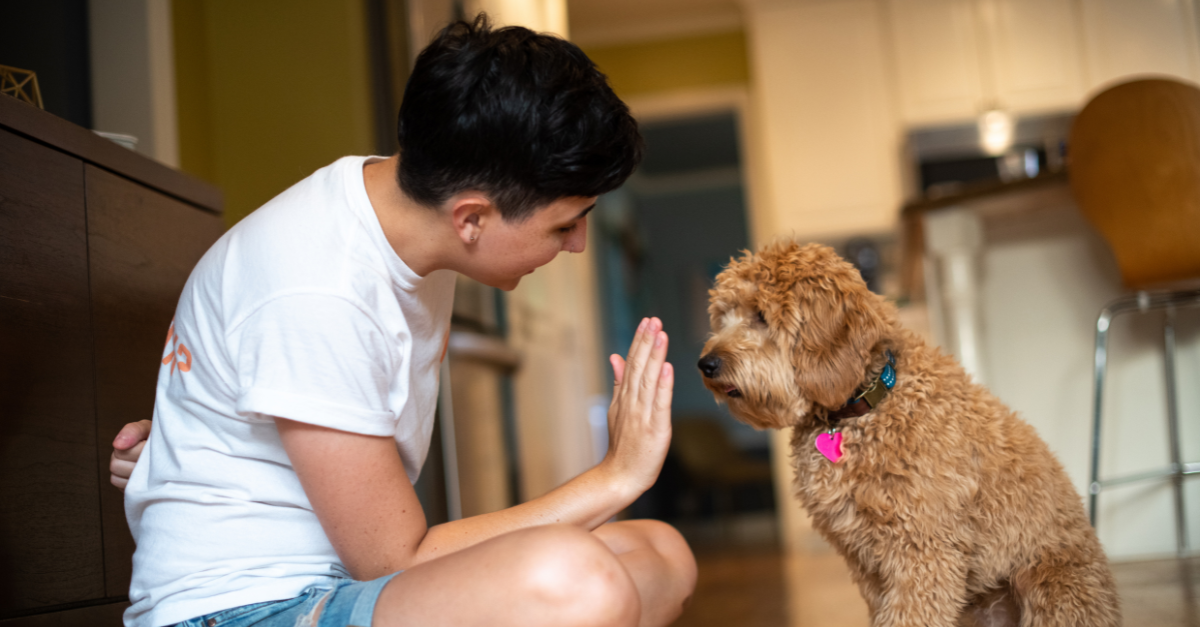While dog discipline vs gentle parenting might sound like comparing apples and tennis balls, there’s a surprising overlap in how we raise babies and our fur babies.
Parenting for dogs isn’t about letting your pup do whatever they want. It’s about building trust, fostering a safe environment, and guiding behavior through consistent structure and emotional connection. Just like toddlers, puppies thrive on routine, clarity, and praise. They’re figuring out the world (and your shoes), and with patience, you can help them grow into confident, well-behaved companions.
Here’s how parenting principles translate into the world of positive reinforcement for puppies, and what dog moms can borrow from their human-parenting playbook.
1. Redirection Instead of Harsh Correction
In gentle parenting, the go-to strategy for unwanted behavior is redirection. Instead of scolding, you steer the child toward acceptable behavior. Puppies benefit from the same approach.
Example: Your puppy bites your hand during play. Instead of yelling, gently say “no bite” and offer a chew toy as an alternative. They learn that teeth belong on toys, not humans. It’s the canine equivalent of saying, “We don’t throw blocks, but we can toss this beanbag.”
Redirection works because it teaches what to do rather than just what not to do. It builds understanding rather than fear, and yes, it takes repetition, but so does parenting a toddler.
2. Praise and Positive Reinforcement
Ask any parent, and they’ll tell you: kids respond better to encouragement than criticism. Puppies are no different.
Positive reinforcement for puppies is about rewarding the behavior you want to see more of. When your pup sits instead of jumping, reward them with a treat and cheerful praise: “Good sit!” They’ll quickly associate sitting with love and snacks.
This method is backed by dog trainers and child psychologists alike. Just like toddlers beam when you clap for them using the potty, puppies soak up praise when they potty outside. Motivation matters, and positive feedback builds confidence and trust.
3. Gentle Boundaries and Consistency
Gentle parenting doesn’t mean parenting without rules—it means setting consistent boundaries in a calm, respectful way. Dogs need this, too.
Example: You don’t want your puppy on the couch. Instead of shouting or physically removing them every time, use a firm but kind tone, teach a "place" command with a cozy dog bed, and consistently redirect them there.
Just like with kids, consistency is everything. If you sometimes allow the couch, they’ll get confused. Clear, loving boundaries help dogs feel secure. You’re not the bad guy—you’re their guide to living happily in your shared space.
4. Time-In Instead of Time-Outs
In gentle parenting, traditional time-outs are often replaced by "time-ins" — moments to calm down together, rather than isolate.
While you can’t talk a puppy through big feelings like you would with a toddler, the concept still applies. If your pup is overexcited, rather than crating them as punishment, guide them to a calm spot with a chew toy. Sit nearby. Help them regulate.
This reinforces calm behavior instead of triggering fear. Dogs don’t learn well through punishment—they learn best when they feel safe, seen, and soothed.
5. Understanding Developmental Stages
Human babies don’t know not to scream at a restaurant, and puppies don’t know not to pee on your rug. Developmentally appropriate expectations are key to both.
Know that puppies need multiple potty breaks a day (some every hour when they’re little), and they chew to relieve teething pain and explore their world. Expect accidents. Expect setbacks. And give grace, just like you would when potty training a toddler.
Gentle parenting—whether for puppies or children—is rooted in empathy. When we understand why a behavior is happening, we can respond with compassion instead of frustration.

Final Thoughts: Lead with Love, No Matter the Species
So, is being a dog mom like being a parent? In many ways, yes. It’s messy, exhausting, joyful, and filled with teachable moments. Gentle parenting for dogs is not only possible, it’s effective—and it helps build a stronger, safer bond between you and your pup.
Training a preschooler or a Pomeranian is surprisingly similar: the tools include patience, redirection, structure, and plenty of praise. And at the end of the day, both your child and your dog want the same thing: your love, your attention, and a little snack never hurts either.
So, dog moms and human moms, keep leading with love. Your kids—furry or otherwise—are lucky to have you.

.webp)

.webp)
.webp)
.webp)


.png)


.png)
.png)